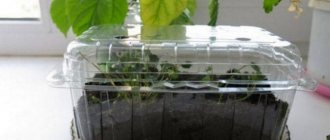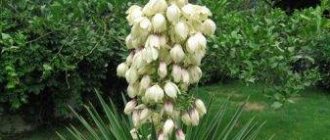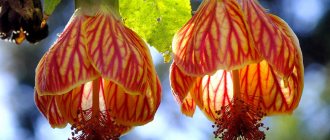- November 1, 2018
- Houseplants
- Nastasya Krakhina
Among flower growers, the campanula flower, which is popularly known as “bride,” is very popular. The plant received such an affectionate nickname due to its appearance - when the delicate flowers bloom, they look like an incredibly beautiful bride’s outfit. There is even a sign that says that if you give this flower to newlyweds for their wedding, their home will be filled with joy and love.
This article will tell you in detail about the features of caring for the “bride” flower at home. The following will describe the rules for watering, planting, selecting temperature, humidity and lighting for favorable plant growth.
Detailed description of the Campanula (“bride”) flower
This indoor plant is a herbaceous plant. It has hanging, creeping shoots. The plant is covered with a large number of flowers that are shaped like a star. Campanula may have white, blue or purple flowers. It is often found that a plant with white flowers is combined with blue ones in the same pot. This gave rise to calling this arrangement of indoor flowers “bride and groom.”
The leaves of the plant are on thin and long petioles. Flowers can reach 3-4 centimeters in diameter. Campanula flower is a perennial plant. If the plant is provided with proper care, it will delight household members with abundant flowering for a very long time.
The intensive flowering period of the “bride” begins in June and ends in October. According to the advice of experienced flower growers, in order for the plant to be especially beautiful during this period and bloom for as long as possible, it is necessary to promptly remove those buds that have begun to dry out.
Which species are suitable for home cultivation?
Flower growers recommend planting two types of campanula at home - equal-leaved and brittle bell. These are the most unpretentious species that do not require too much attention.
However, if you want to plant Campanula as a couple - “bride and groom”, then you should adhere to the following varietal scheme:
- Alba ("bride") and Maya ("groom"). Alba is the oldest and most proven variety that has been grown at home for more than 50 years. Its abundant bloom of white flowers pleases the eye. Maya has blue flowers, velvet stems and leaves. This pair of varieties goes well together.
- Atlanta ("bride") and Napoli ("groom"). These two varieties are representatives of modern selection. The white “bride” Campanula Atlanta, unlike its ancestors, is more compact, and its flowering is abundant. The Napoli variety has bright blue flowers, and the bush is more branched. Today, Napoli is considered a noble variety of domestic plants.
- Dublin white (“bride”) and Dublin blue (“groom”). These varieties are distinguished by the fact that they have double flowers and abundant flowering.
- White portenschlag (“bride”) and blue portenschlag (“groom”). Such indoor flowers “bride and groom” of these varieties are distinguished by the fact that they have small spherical flowers. In addition, these two varieties bloom continuously.
- Dublin white 2 (“bride”) and cirillo (“groom”). “Bride” is an improved version of the Dublin white variety. It also has double flowers. In general, the plant is very compact and blooms with a beautiful cap. And the Cirillo variety is rare and very unusual. It has blue flowers with a darkened center. Rosettes form on the tendrils-shoots, which provides a lush cascade of flowers. The variety is named after the famous botanist from Italy Domenico Cirillo.
Transplanting myrtle ornamental
It is carried out either when the bush has grown out of the pot and it has become crowded there, or to prevent the death of the plant.
Regardless of the reason, the sequence of actions during transplantation is as follows:
- Before transplanting, it is recommended not to water the tree for a day or two to allow the soil to dry out. This will make it easier to remove it from the pot.
- Prepare a new pot. Don’t forget to fill it with expanded clay and drainage, and top half with substrate (its composition will be indicated below).
- Turn the pot over, carefully grab the flower by the base and pull it out.
- Inspect the roots and lower parts of the leaves to see if they have begun to rot, if there are marks there that should not be there, or colonies of pests (see the section “Diseases and Pests” to find out what exactly this could be).
- If something appears, it is better to first treat the plant in accordance with the diagnosis, and only then replant it, so as not to drag the disease to a new place.
- If everything is in order, then treat the myrtle roots with a growth stimulant - this will help it take root in a new place, since myrtle usually does not tolerate transplantation.
- Place the tree in a pot and fill in the remaining substrate.
- Water thoroughly and move to shade.
When can you replant?
Preferably in winter. Winter is a dormant period for the plant, so it can easily withstand the stress of replanting. An exception is replanting for sanitary purposes (for example, if the plant is waterlogged and is transplanted into drier soil for replanting).
How often should a myrtle tree be replanted?
Young trees grow quickly, so they quickly grow out of the pot; their root system becomes crowded there. Therefore, they are replanted annually. And plants older than four to five years are rarely replanted: approximately once every three to four years.
Priming
You can buy ready-made soil. If you decide to do it yourself, then take peat, turf, humus and river sand. There should be equal amounts of peat and turf, but slightly more than humus and sand. Humus and sand are also equally divided.
Myrtle pot
It should be large both in width and height, since myrtle has a developed root system. However, not too big, otherwise moisture will accumulate at the bottom and the roots will rot. It is optimal if there are two to three centimeters between the roots and the walls of the pot. Material – preferably plastic.
Flower bride: care at home, features
As noted earlier, caring for this plant is very simple and does not require excessive effort on the part of the grower. You can grow campanula from seeds, and the most important thing during this period is to provide the plant with good lighting and watering.
At the time of planting, it is necessary to take into account that the plant has hanging shoots. Therefore, the best option is to plant it in hanging pots (plant pots).
Of course, like all plants, campanula requires compliance with the rules of watering, fertilizing, selection of lighting and humidity when caring for it. It's worth taking a closer look at them.
Diseases and pests
If the campanula is not watered correctly or does not provide it with suitable conditions for growth, this can cause the development of a fungal disease. In order to cure a flower, cut off all affected stems and foliage, then spray the plant and the surface of the substrate in the pot with a fungicide.
If the air humidity in the room is extremely low, then a spider mite or scale insect may settle on the flower. Such insects are sucking, and they feed on the cellular sap of the flower. If ticks settle on the bush, it should be treated with an acaricide, for example: Actellik, Fitoverm or Aktara. It is not so easy to deal with scale insects, since they are protected by a chitinous shell and covered with wax on top. First, scale insects should be removed from the bush with a very hard brush, and then it should be sprayed with acaricide. If the bush is severely affected by a fungal disease or there are a lot of pests on it, then it should be treated several times with an interval of 1–1.5 weeks.
On an absolutely healthy bush, leaf plates may begin to turn yellow. This is usually due to prolonged exposure to direct sunlight. Strongly elongated shoots indicate excessively poor lighting.
Watering
The Campanula flower adapts perfectly to water of any hardness. However, it is best to use regular tap water, which has been left to sit for several days. In the warm season, watering becomes more frequent, and in the cold season it is done less frequently.
You can determine a flower's need for water by testing the soil; it should be slightly moist. This is key when maintaining a flower bride. Care at home requires that there is no stagnation of water in the pot.
Top dressing
Campanula, like all other plants, periodically needs feeding. This is due to the fact that the soil in pots gradually releases all the nutrients to the plant and becomes neutral.
Mineral and organic fertilizers will help ensure a healthy plant. Feeding should be done in small quantities once a month. Flower growers note that the best fertilizer for campanula is a solution of the Kemira-Lux preparation.
During the period of abundant growth, you can feed the young plant once every ten days. This is also one of the key points when maintaining a “bride” flower. Home care requires that the plant always has enough nutrients.
Air
For good growth and health, it is necessary to provide the correct air for the campanula. At home, care requires observing the temperature regime and maintaining the required level of humidity. In summer, the optimal temperature for the “bride” will be up to +25 °C, and in winter – about +12 °C. The plant loves to breathe fresh air, so placing it on a balcony or terrace from spring to autumn is considered an excellent option.
Campanula loves moderate humidity, but absolutely does not tolerate drought. Therefore, you should spray the leaves with a small amount of water in the warm season.
Reproduction methods
To propagate indoor campanula, the seed method is used, as well as cuttings, dividing the bush and planting young shoots. At the same time, vegetative methods are more popular among gardeners, since they are simpler and more effective compared to seed methods.
Cuttings
To cut cuttings, use the lower parts of the shoots remaining after pruning. For rooting, they are planted in a substrate of sand and peat, which is spilled with Fitosporin, and they are covered with a transparent dome on top. At temperatures from 20 to 25 degrees, the cuttings take root quite quickly. During rooting, the cuttings are not watered; they are only systematically moistened with a sprayer. After the cuttings reach a height of about 10 centimeters, pinch their tops to make the bushes more lush.
Reproduction by young shoots
After young shoots grow on the bush in spring, separate several pieces along with the heels. Plant the shoots for rooting in the same substrate as the cuttings, and also cover them with a transparent cap. For rooting to be successful, the shoots must be kept cool (about 12 degrees). The roots on the shoots should grow in 20–30 days; immediately after young foliage appears on the plants, remove the shelter and move them to a warm, well-lit place (the light should be diffused).
Dividing the bush
A heavily overgrown bush can be divided into parts during transplantation. Treat the cut areas with charcoal powder. After this, the divisions are planted in separate containers. The planted cuttings are well watered and protected from direct sun rays for the first days.
Growing from seeds
Seeds are sown in early spring. For sowing, use a bowl, which is filled with seedling soil mixture. Bell seeds are very small, they are evenly distributed over the surface of the substrate and covered with a thin layer of earth on top. The crops are moistened very carefully using a sprayer. The emerging seedlings also need to be watered using a spray bottle. They are picked into individual cups after they have formed 3 true leaf plates.











